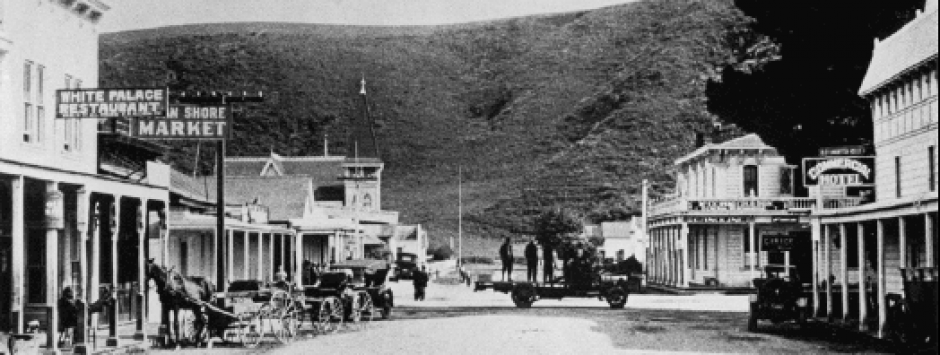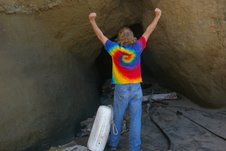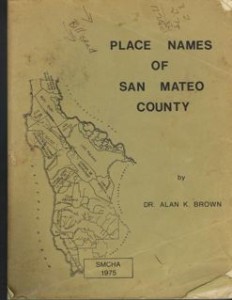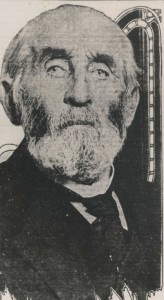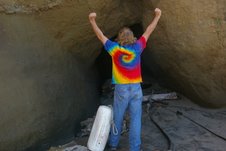Story by June Morrall
[Note: If you’ve been following “The Coburn Mystery” you may see less obvious links to the Pescadero story.]
It was widely known that San Mateo County Judge Horace Templeton stuck to a friend like a brother. It was also known that “Old Temp,” as he liked to be addressed, “hated his enemies with a hatred good and genuine, a hatred that bristled all over with a prick.”
“When I’m off the bench, you can call me ‘Temp,'” advised Horace Templeton. “But when I’m on the bench, you’d best call me ‘Judge,’ and friends and foes will get their desserts alike.”
Born in Vermont in 1824, he 29-year-old bachelor traveled to California, where the whirring sound of sawmills, drew him to the thick redwoods near present-day Woodside. The forest was so isolated that deserters from the British navy and the Hudson Bay Company’s whaling ship Nereid found safety there.
Shortly after Tempeton’s arrival, the town was named Searsville in honor of John Sears, who opened and operated a busy hotel in the busy mill town.
On their way to the Port of Redwood City, all the neighboring lumber companies including Mountain Home, Smith, Mastick and Spaulding Mills, hauled their cut timber through Searsville. The route ran past Dr. R. O. Tripp’s store, today the Woodside Store, maintained by the San Mateo County History Museum.
Horace Templeton witnessed Searsville’s boom. Hundreds of mill boys, employed in the surrounding redwood groves, came to Sunday afternoons for horse racing, fighting, and the famous poker games, with the stakes reaching as high as $1, 000 per hand.
Stages and fashionable carriages dashed up to the hitching post of a second hotel operated by August Elkerenkotter, a Prussian by birth. For a moment in the county’s history, tiny Searsville was at the bustling center of the Peninsula’s lumber industry and its related social life.
Some locals said that Horace Templeton arrived at Searsville with money saved in Vermont. Others gossiped that Templeton’s crooked poker skills enabled him to launch his own business, Templeton’s Mill, in the heart of the redwood forest.
San Mateo County historian John G. Edmonds, attesting to Templeton’s poker talent once wrote: “Lumber was not ‘Temp’s’ most lucrative source of income. He loved to play poker and he was never known to lose a game.”
In time, Templeton became Searsville’s Justice of the Peace. By 1861 Horace Templeton resided in Redwood City, where large majorities of voters elected him to the first of several terms as a county judge.
Close to Valentine’s Day in 1866, Judge Templeton, now 42, married Ellen Crowley. Two years later, the couple had a son, Robert.
Success made ‘Temp’ an acknowledged leader, a prominent target of praise and condemnation. It was said he played “a bold hand in business and always for keeps.”
“Anything but defeat” was Horace Templeton’s motto. This motto was to be severely tested near the Coastside village of Pescadero.
In the early 1870s, Pigeon Point Landing, six miles south of Pescadero, attracted the attention of Templeton and two allies: former supervisor Josiah P. Ames and Charles Goodall, the president of the Pacific Coast Steamship Company.
Ames was the force behind the colorful, bustling wharf at Amesport Landing (Miramar Beach), four miles north of Half Moon Bay. Charles Goodall’s steamers picked up the local produce.
Most people considered the trio a powerful group representing local interests. Their detractors labeled them an “unscrupulous ring of speculators.”
By this time Judge Templeton’s sawmill interests had expanded to the Gazos Creek area, south of Pescadero. Templeton realized profits would rise if he gained control of Pigeon Point Landing. the only convenient nearby outlet for shipping.
The Pigeon Point Landing had been cleverly designed with a chute and long outstretching booms and tackle by which small boats were loaded just inside the protective rock on which the lighthouse was built. On the bluff above the landing, stood several large storehouses. Portuguese whalers had built cottages and a look-out station there.
Blocking Templeton and his associate’s goals as Loren Coburn, an eccentric, controversial millionaire who had moved from San Francisco to be closer to the 10,000 acres of land he owned in and around Pescadero. As owner of Pigeon Point Landing, Coburn had leased out the property for ten years, but that agreement was about to expire. Coburn’s plan was to take over the operation. He was thwarted when Templeton, Ames and Goodall shrewedly took over the remainder of the lease from Coburn’s renters. They won permission from the Board of Supervisors to build a new wharf and pier there.
This was a risky strategy—-Coburn intended to take over the landing at the end of the lease, grateful for all the improvements.
The lease with Coburn expired, but the men had no intention of honoring the contract and turning the property back to him. When told to vacate Pigeon Point Landing, Templeton and his partners offered to buy the land but Coburn refused to sell. Then they refused to leave. By summer, Coburn tried to evict the men unsuccessfully.
The Pescaderans, who had many reasons to dislike Loren Coburn, one being that he refused to pay the local school tax, sided with the speculators. The villagers were not impressed with this “San Francisco capitalist” who wore old-fashioned black swallow-tail coats, talked too fast and drove his horses recklessly across the countryside.
Using their political connections, Ames and Templeton petitioned the Board of Supervisors for a wharf franchise, proposing to further modernize the facilities in return for 20 years of use. The petition failed, but the county responded favorably by condemning the land and surveying a road which ran to the end of the loading chute. Coburn retaliated by sending his lawyer to the State District Court in San Francisco.
The court reversed the condemnation on the grounds that the lands were not properly identified, and that the road to the wharf was a private road. The only public property, said the court, was the land within high tide.
Despite the ruling, Coburn could not get physical possession of the landing. The sheriff, who accompanied him with the court order, claimed that he was not certain from the document where the property was located.
Into the intricate legal battle walked C.N. Fox, a former county attorney who represented Judge Templeton. Fox appealed to the State Supreme Court on behalf of his client. Complaints, court orders, counter-orders, and injunctions crossed his desk for 12 months.
Most of the wharf extended into the high tide and the calculating, anti-Coburn investors saw that it was to their advantage to separate it from the private land. The men put up a gate across the wharf at the point where it stretched 100 feet into the high tide, thus officially disconnecting the public property, where they conducted their shipping business, from Coburn’s private property. Armed with a navy six-shooter, Alexander “Scotty” Rae was hired by Templeton and his partners to patrol the gate.
Although the lease had expired, and the San Francisco court ruled that Coburn should regain his land, the Templeton group continued their shipping opration.
While visiting Pigeon Point Landing in February of 1873, then 49-year-old Judge Templeton fell down a cliff, struck his head and was seriously injured. Was he pushed by one of Coburn’s men as a warning of the violence to come?
Judge Horace Templeton’s health deteriorated. None of the doctors at his bedside could cure the “violent pain in his head,” and ten days later he died. Templeton was buried at Redwood City’s historic Union Cemetery.
The struggle over control of Pigeon Point continued, with Templeton’s partners continuing to work on the high-tide side of the wharf.
When the State Supreme Court finally awarded Coburn possession of the wharf, Josiah Ames and Charles Goodall still would not vacate. Coburn’s lawyer, San Francisco attorney William Craig, advised his client to take possession of the wharf peacefully. Shunning Craig’s advice, Coburn hired four gunslingers in San Francisco and brought them back to Pigeon Point.
Nearly two years after Templeton’s death, Coburn’s gunslingers took possession of the loading chute, building a breastwork of planks two feet high across the chute. In the early morning hours when Scotty Rae, who shared an office with the telegraph operator, saw the fortifications, he reached for his navy six-shooter. He rushed down the chute, cursing and threatening as he advanced–this despite the number of cocked guns pointed at him.
The gunfighters warned Rae that he had better not set foot on the wharf. The argument grew heated, with Rae impulsively firing at one of the gunfighters, but missing. In the flash of a gun, Scotty Rae was a corpse; five balls were lodged in his body, one through the heart.
When news of Rae’s death reached Pescadero, the sentiment against Coburn was intense.
“Lynch him, lynch him,” was the cry as a mob stormed Pigeon Point.
A few hours after the killing, the county coroner impaneled a jury of Pescaderans for the inquest. After quick deliberation, Coburn and the four gunfighters were charged with murder. At the Redwood City jail, Coburn and his hired guns posted bail.
After two murder trials, the first resulting in a hung jury, Judge Daingerfield dismissed the case for insufficient evidence.
In 1878, five years after Judge Horace Templeton’s death, three years after Rae’s death, and after endless amounts of cash had been poured into litigation. Pigeon Point Landing was finally awarded to Coburn.
Horace Templeton’s influence spanned from Searsville to Pigeon Point Landing. In 1891, after the houses of Searsville were moved, the village vanished as the site was flooded by a man-made lake, today part of the Jasper Ridge Biological Preserve. The wharf at Pigeon Point Landing no longer exists.
…more coming….
